Gruntwork Reference Architecture Setup Instructions
This repository is used to generate the code to deploy and manage the the Gruntwork Reference Architecture. You will receive an automated email at the end of the deployment indicating that the initial deployment has finished, which includes instructions for copying the code to your own repository outside of the gruntwork-clients GitHub organization.
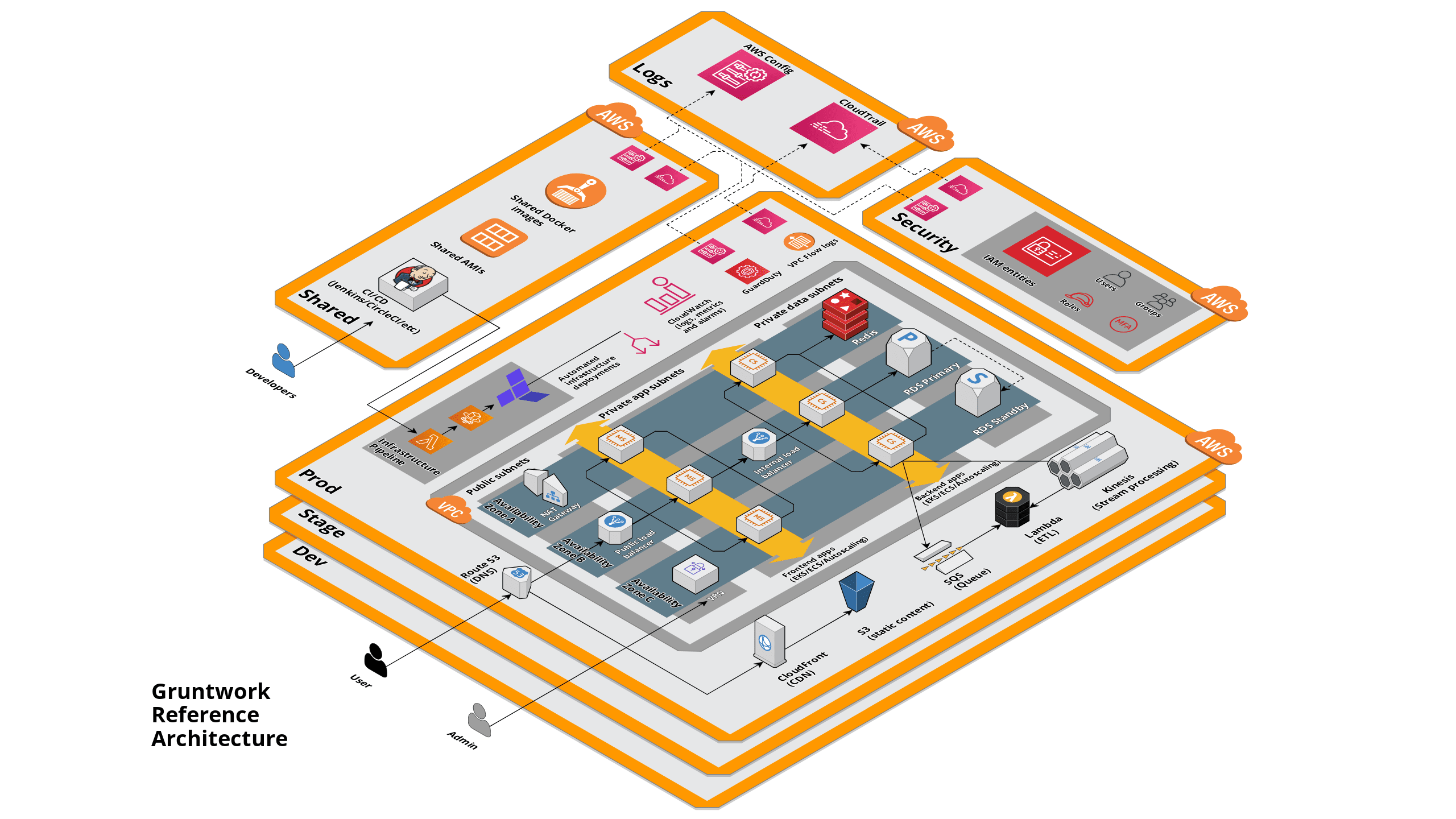 Landing Zone Reference Architecture
Landing Zone Reference Architecture
Follow the instructions below to prepare for a Reference Architecture deployment:
We recommend that you use the Gruntwork CLI tool to automate most of this process for you: https://github.com/gruntwork-io/gruntwork. Note that the Gruntwork CLI is in a private repo that is part of the Gruntwork IaC Library. If you don’t already have access to the Library, please email support@gruntwork.io to get access, or you will get a 404! Once you have access, follow the documentation in the README closely!
Caveat: at this time, the Reference Architecture does not configure or manage the root/management account of an AWS Organization set up. That is, it does not include the account-baseline-root module. Gruntwork is planning to add this in a future enhancement to the reference architecture.
1. Create an infrastructure-live repository
- Create a new repository in your VCS platform. We recommend naming it infrastructure-live.
- Keep this repo handy, as you'll be prompted for the following information in a subsequent step:
- HTTPS URL (e.g.
https://github.com/gruntwork-io/infrastructure-live) - SSH URL (e.g.
git@github.com:gruntwork-io/infrastructure-live.git) - Default branch (e.g.
mainormaster)
- HTTPS URL (e.g.
2. Set up the machine user
The next step is to configure the Machine User Personal Access Token(s) (PAT)
If you are using GitHub to host your infrastructure-live repository, you will only need the one
PAT as the permissions will allow access to both your infrastructure-live repo and
Gruntwork's private repositories.
If you are using GitLab or Bitbucket to host your infrastructure-live repository, you will need a
PAT for your respective VCS in addition to a GitHub PAT for access to the
private Gruntwork GitHub repositories. Note that at this time GitHub is the only supported VCS for
Reference Architecture deployments.
First we will create a GitHub Personal Access Token:
- In GitHub, create a new user account, then create a Personal Access Token.
- In the ref arch form,
MachineUserGitUsernameandMachineUserGitEmailis where you enter this account’s details. - In the Gruntwork developer portal, add the user to your team, then log in to the portal as the machine user and link the GitHub account. You’ll know it’s set up correctly when you see the Gruntwork icon in the machine user’s GitHub profile, indicating that they are a member of the Gruntwork Organization.
- The PAT should be granted
repo,user:email, andadmin:public_keypermissions. You should includeGitHub-MachineUser-PATas part of the name/description of the token to be able to identify it later. - Once you have the PAT, create a new AWS Secrets Manager secret in the shared account. You can use any name you wish for this secret, but it's recommended you include
GitHub-MachineUser-PATas part of the name to be able to identify it later. See the section Appendix: How to create a secret for the VCS token in AWS Secrets Manager for details. - Once the secret is created, copy the ARN to your favorite text editor for the next step.
ß
If your
infrastructure-liverepository is hosted in GitHub, enter the secrets manager ARN from the above steps into the Ref ArchVCSPATSecretsManagerARNfield. This token will provide access to both yourinfrastructure-liverepo and to the Gruntwork private repositories and you are done setting up the machine user! You can skip to the next section.
If your infrastructure-live repository is hosted in BitBucket or GitLab, expand the BitBucket / GitLab tab below for more details.
BitBucket / GitLab Guide
Note that at this time, GitHub is the only supported VCS for Reference Architecture deployments.
If you are using GitLab or BitBucket to host your infrastructure-live repository, enter the secrets manager ARN from the above steps into the GitHubPATSecretsManagerARN field. Since this token will provide access to only the Gruntwork private repositories, we will next need to create the token to access your infrastructure-live repo.
For GitLab, use these instructions, and grant the following scopes (NOTE:
api,read_user, andread_apiscopes are only used for uploading the public SSH key for the user. You can replace the token with a new one that only haswrite_repositorypermission after the Reference Architecture is deployed.):write_repositoryapiread_userread_api
You should name the token
GitLab-MachineUser-PATto be able to identify it laterFor Bitbucket, use these instructions, and grant the following scopes (NOTE:
Account:Writeis only used for uploading the public SSH key for the user. You can replace the token with a new one that only hasRepositories:Writepermission after the Reference Architecture is deployed.):Repositories:WriteAccount:Write
You should name the token
BitBucket-MachineUser-PATto be able to identify it later.
Now you will need to create another secret in AWS Secrets Manager in the shared account containing this PAT. You should name the secret following the above naming convention (GitLab-MachineUser-PAT/BitBucket-MachineUser-PAT). Once the secret is created, copy the ARN to your favorite text editor for the next step.
Finally, enter the newly created GitLab-MachineUser-PAT/BitBucket-MachineUser-PAT secrets manager ARN from the above step into the Ref Arch VCSPATSecretsManagerARN field.
Explanation
The reference architecture includes an end-to-end CI/CD pipeline for infrastructure. You’ll need to set up a machine user (also known as a service account) that will automatically checkout your code, push artifacts (such as Docker images and AMIs), and access the Gruntwork IaC Library.
There are two primary uses for the Machine User:
- Accessing Gruntwork private repositories hosted in GitHub
- Accessing your
infrastructure-liverepository that is hosted in GitHub, BitBucket, or GitLab
You need at least one machine user in GitHub to access the repos in the Gruntwork IaC Library private repositories. If you are using GitHub to host your infrastructure-live repo then this machine user PAT will also grant all the access you will need.
If you have chosen Bitbucket or GitLab to host your infrastructure-live repo, then you will need a second PAT that grants access to that repo.
In the reference-architecture-form.yml there are two fields that relate to the machine user PAT(s)
VCSPATSecretsManagerARNGitHubPATSecretsManagerARN
VCSPATSecretsManagerARN is for the secrets manager ARN that contains the PAT for your VCS system hosting your infrastructure-live repo. If your VCS happens to be GitHub then it automatically grants all the access you need and you can set GitHubPATSecretsManagerARN to an empty string as it is not needed.
Since BitBucket and GitLab PATs wouldn't grant access to GitHub, the additional GitHubPATSecretsManagerARN is needed in order to access Gruntwork Private IaC Library repositories.
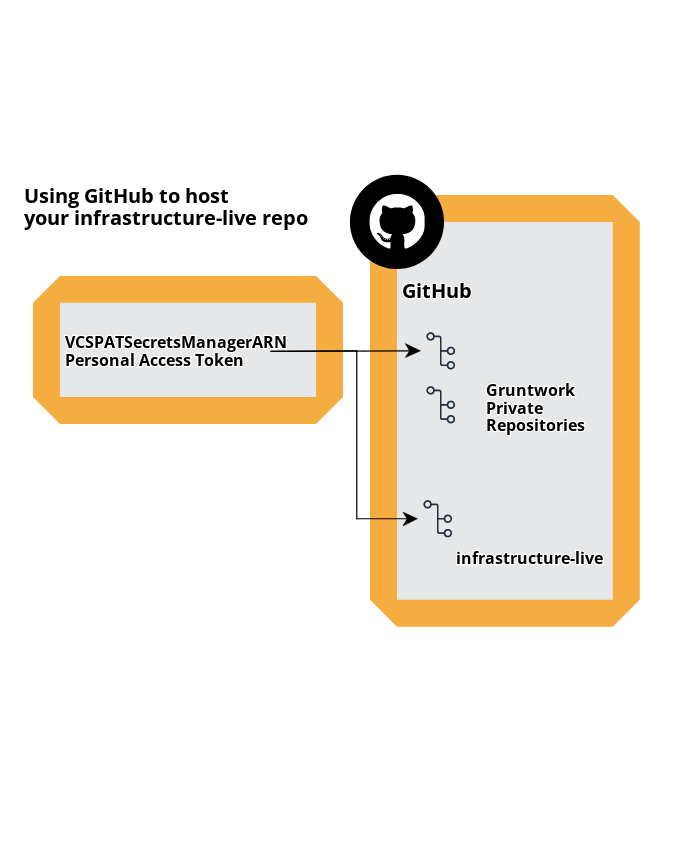
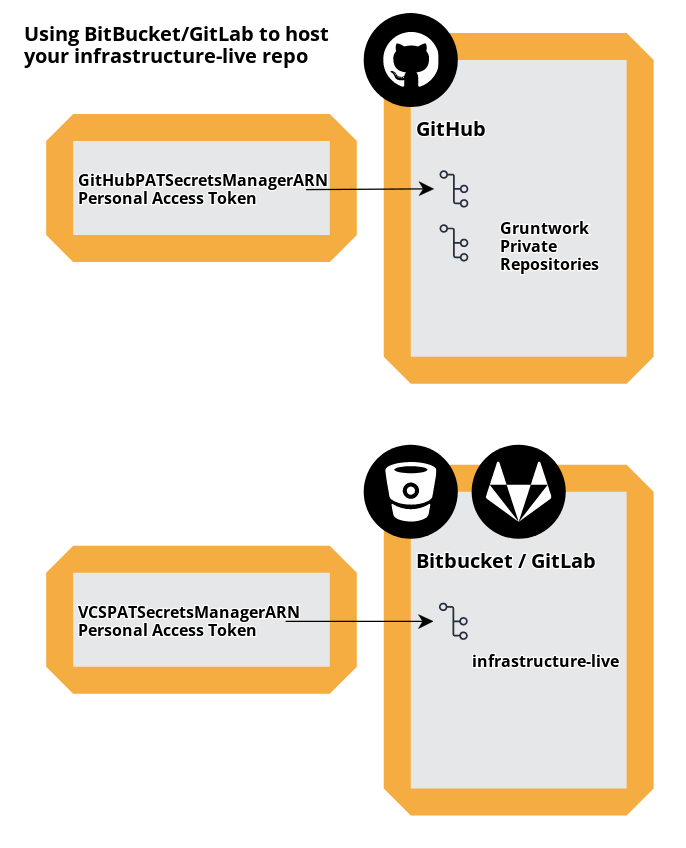 GitHubPATSecretsManagerARN
GitHubPATSecretsManagerARN
3. Clone this repository
Use Git to clone this repository. If you do not have git available on your system, refer to these instructions to install Git on your platform.
Clone the repository.
git clone git@github.com:gruntwork-clients/<this-repo>.git
4. Authenticate to AWS on your command line
The bootstrap script will prepare your AWS accounts for deployment. To use the bootstrap script and form filling wizard, the CLI will need access to your AWS Root account you would like to use for the Reference Architecture. The Root account is where the AWS Organization is defined.
- If you do not have a Root account (an AWS account with AWS Organizations setup) already, create one. We recommend creating a brand new account to use as the Root account if you are not already using AWS Organizations, and import your existing AWS Account(s) to it as members.
- Setup AWS Organizations in your Root account if you haven't already. Refer to this documentation for instructions on how to setup AWS Organizations.
- If you do not have one already, create an IAM
User with administrator permissions (attach
the
AdministratorAccessIAM policy). Make sure to create AWS Access Keys for the IAM User as well. - Once you have an IAM User and AWS Access Keys for accessing the Root account, configure your terminal to be able to authenticate to the IAM User. If you do not know how to do this, refer to our Comprehensive Guide to Authenticating to AWS on the Command Line.
5. Run the bootstrap script
We're ready to run the wizard to fill in your reference-architecture-form.yml with valid values.
Before running the wizard, ensure you have completed steps 1, 2 and 3 and that you have the following values ready at hand:
- PAT for YOUR GitHub user. This token is used to create the Pull Request for the Reference Architecture form.
- If you do not have one, generate a new PAT with
repolevel permissions.
- If you do not have one, generate a new PAT with
- GitHub Machine User PAT (required in all cases)
- VCS Machine User PAT (only required if your ultimate infrastructure-live destination is NOT GitHub)
- The HTTPS URL to your VCS
infrastructure-liverepo (e.g.,https://github.com/gruntwork-io/infrastructure-live.git) - The SSH URL to your same VCS
infrastructure-liverepo (e.g.,git@github.com:gruntwork-io/infrastructure-live.git)
In your repo, you will find two scripts:
bootstrap_unix.shbootstrap_windows.py
Both scripts will:
- Sanity check that you have access to the required organizations.
- Install the Gruntwork command line tool, which does all the heavy lifting for you
- Run the Gruntwork wizard for you, which helps you:
- Provision your AWS accounts
- Register domains
- Set up your VCS token secrets
- Fill in your reference-architecture-form.yml file with valid values
- Commit and push your form to GitHub and open a pull request
Run the corresponding script based on your platform:
Linux or Mac OS
export GITHUB_OAUTH_TOKEN=<YOUR GITHUB PERSONAL ACCESS TOKEN>
./bootstrap_unix.sh
Windows
Install python, and then run:
$env:GITHUB_OAUTH_TOKEN = 'YOUR GITHUB PERSONAL ACCESS TOKEN'
python3 bootstrap_windows.py
6. Iterate on your form and push your changes up to run your Preflight Checks
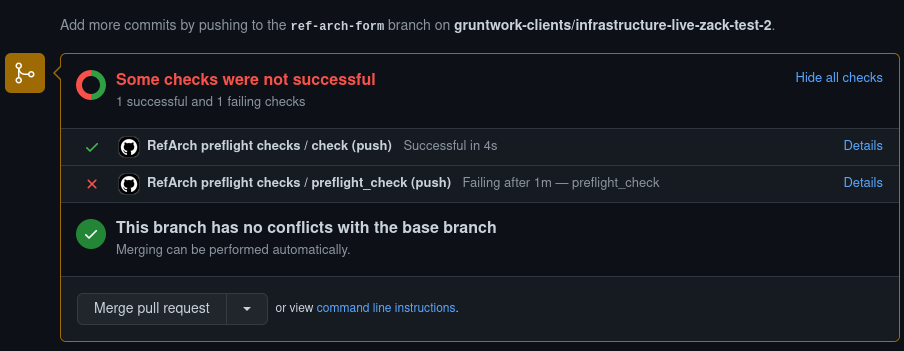 Gruntwork Preflight Checks on GitHub
Gruntwork Preflight Checks on GitHub
Once your form is filled in and pushed to GitHub, our automations will take over via GitHub Actions. You'll notice a special GitHub check called Preflight Checks that will run against your reference-architecture-form.yml file and flag any errors for you directly in your pull request, like so:
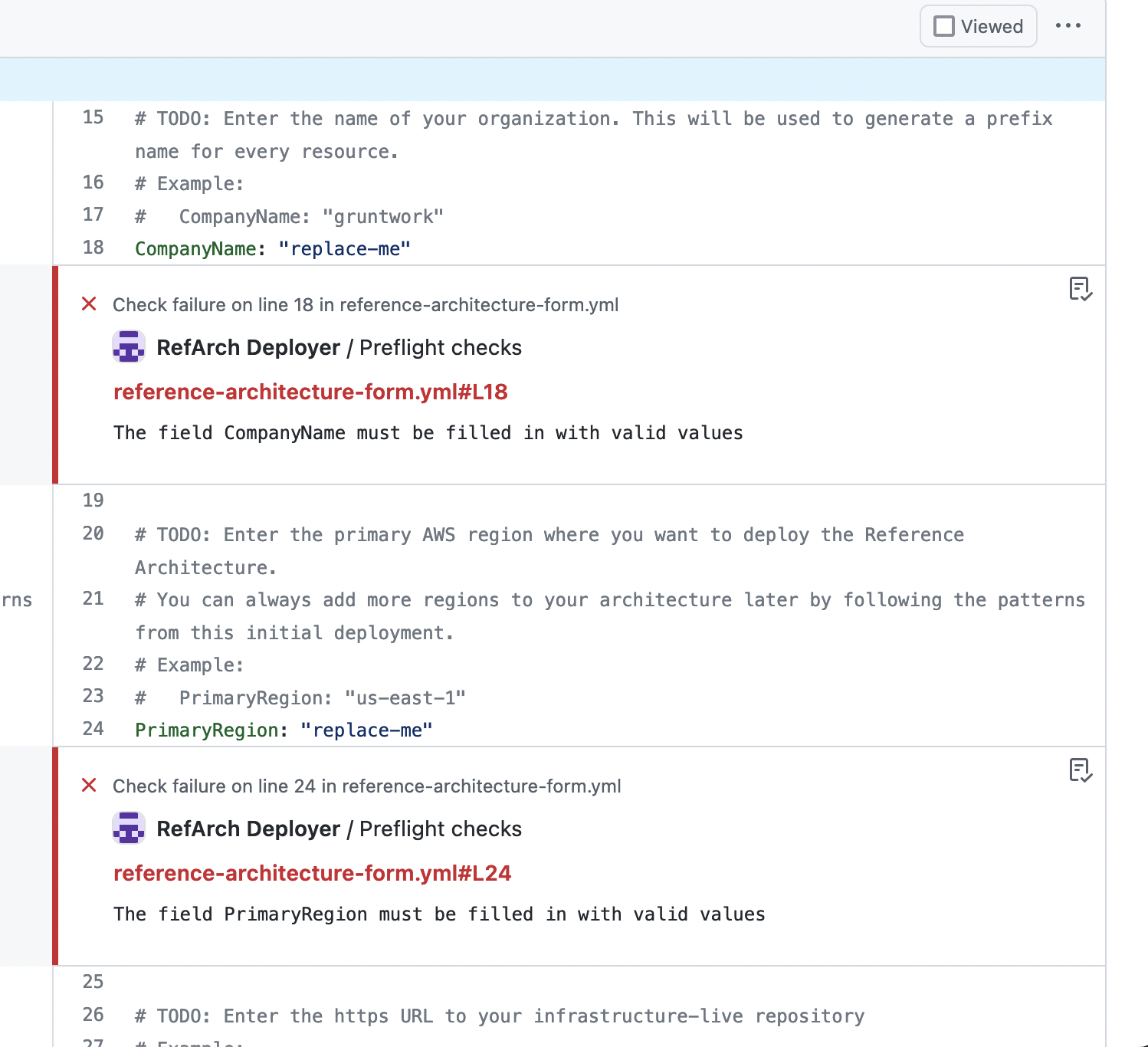 Gruntwork Preflight Checks
Gruntwork Preflight Checks
You can then locally iterate on your form by editing reference-architecture-form.yml on the ref-arch-form branch and pushing your changes up to GitHub. Each time you make a new commit and push it, the Gruntwork Preflight Checks will be run against your form.
Next Steps
Once all your Preflight Checks pass, you can merge your pull request, which will commence your Ref Arch deployment.
Gruntwork engineers are automatically notified of each new Ref Arch deployment, so there's no need to reach out to support just to inform us that your deployment has commenced.
Gruntwork engineers will monitor your deployment and receive notifications about failures and issues that may require intervention to resolve.
Gruntwork engineers rotate through all active deployments to fix up issues preventing them from making forward progress. In general, deployments take "A few days", although there are plenty of variables outside of our control that can occasionally interfere with a deployment, and which may take longer to remediate.
Gruntwork engineers will reach out to you to communicate a status update or next steps if your deployment requires additional intervention to complete.
Manual setup instructions
Click here if you would like to perform the setup actions manually
Visit the Gruntwork releases page
Find and download the correct binary for your platform.
Mac and Linux instructions
Mac and Linux users, move it into /usr/local/bin/. For example, assuming you downloaded gruntwork_linux_amd64:
sudo mv ~/Downloads/gruntwork_linux_amd64 /usr/local/bin/gruntwork
Make the binary executable
chmod +x /usr/local/bin/gruntwork
Run the setup wizard
gruntwork wizard
Windows users
Download and move your binary to your C:\Program Files directory.
Append the full path to your gruntwork binary to your system's PATH.
Run the setup wizard
gruntwork wizard
Frequently Asked Questions (F.A.Q)
Click to expand the FAQ section
Why do I need to create another repository? Can't I use this repository for my infrastructure code?
Our Reference Architecture deployment process depends on having access to the code. In lieu of requesting for access to
a repository that you own, we use this current repository in the gruntwork-clients GitHub organization to stage the
code for the Reference Architecture deployment.
This code should be moved to a repository that you have full control over once everything is deployed.
Why do I need a machine user?
The reference architecture includes an end-to-end CI/CD pipeline for infrastructure. You’ll need to set up a machine user (also known as a service account) that will automatically checkout your code, push artifacts (such as Docker images and AMIs), and access the Gruntwork IaC Library.
You need one machine user in GitHub to access the repos in the Gruntwork IaC Library.
What are the various Ref Arch accounts used for?
This is the breakdown of AWS accounts in the Reference Architecture:
- Security: for centralized authentication to other accounts, including management of IAM users, groups, and roles.
- Logs: A log archive account that contains a central Amazon S3 bucket for storing copies of all AWS CloudTrail and AWS Config log files.
- Shared: Shared services account for sharing resources such as Amazon Machine Images (AMIs) and Docker images with other accounts. This account can also be used to provide common infrastructure such as monitoring systems (e.g. Grafana) with other accounts.
- Dev: A dedicated app account for development purposes, intended to isolate early development releases from the rest of your infrastructure.
- Stage: A dedicated app account for hosting staging, testing, and/or QA environments.
- Prod: A dedicated app account for production deployments, intended for live environments used by customers.
Where can I read the Ref Arch Setup FAQ?
Please find our Reference Architecture Pre-Deployment FAQ page here.
How do I commit and push my form changes?
Committing changes and pushing to the remote repository:
git add reference-architecture-form.yml
git commit -m 'Completed reference architecture form.'
git push origin ref-arch-form
How do I open a pull request with my changes?
See the GitHub docs on how to open a pull request.
How do I create a secret for the VCS token in AWS Secrets Manager?
To create a secret in AWS Secrets Manager, first open the AWS console for the shared AWS account, and navigate to the Secrets Manager console.
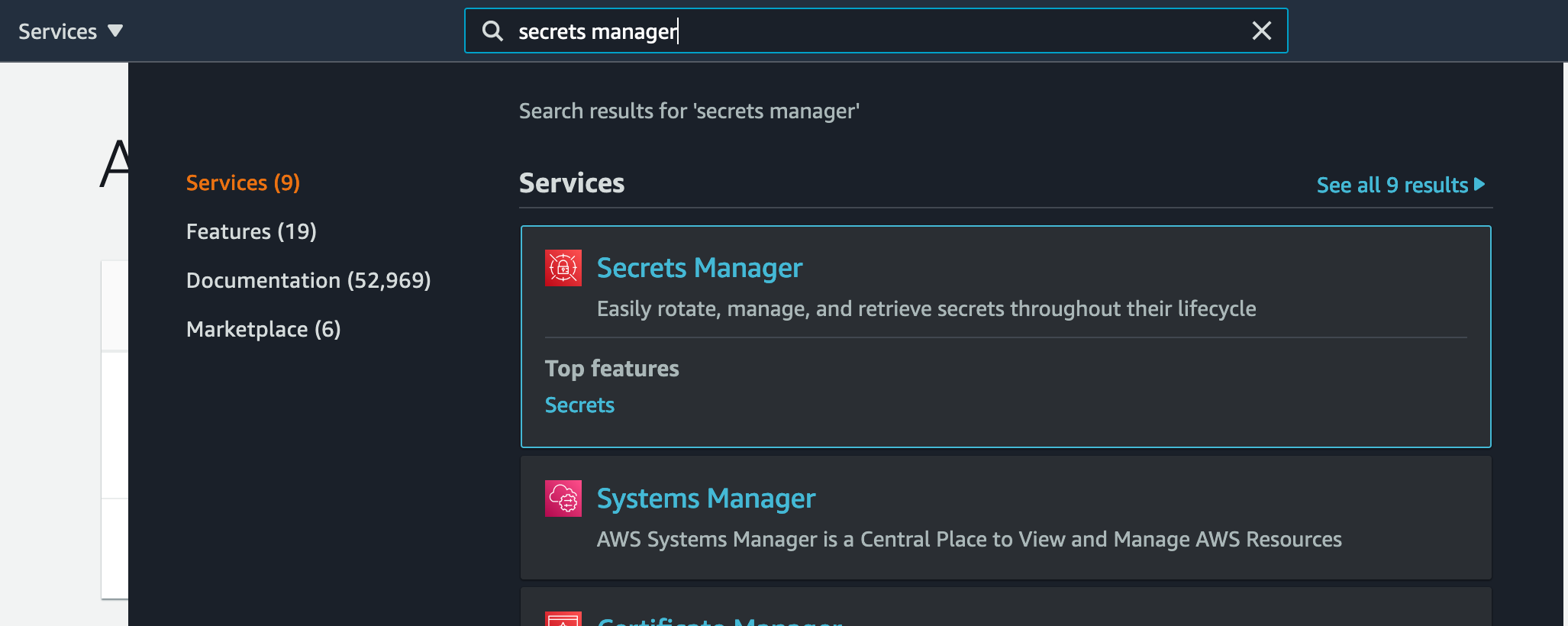
Next, choose Store a new secret.

Choose Other types of secrets, then click on Plaintext, then paste the value of your PAT in the text field.
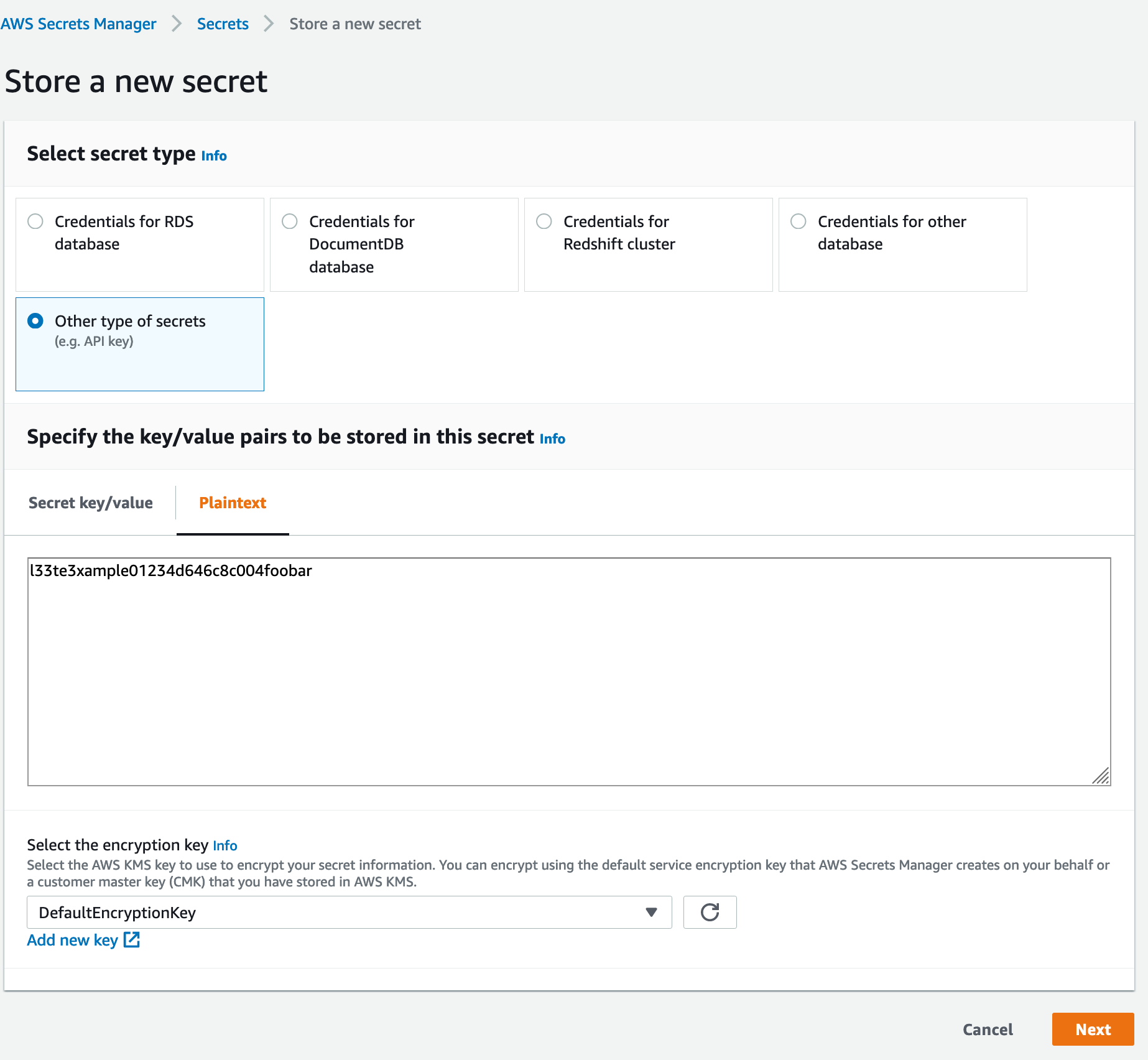
Click Next to continue.
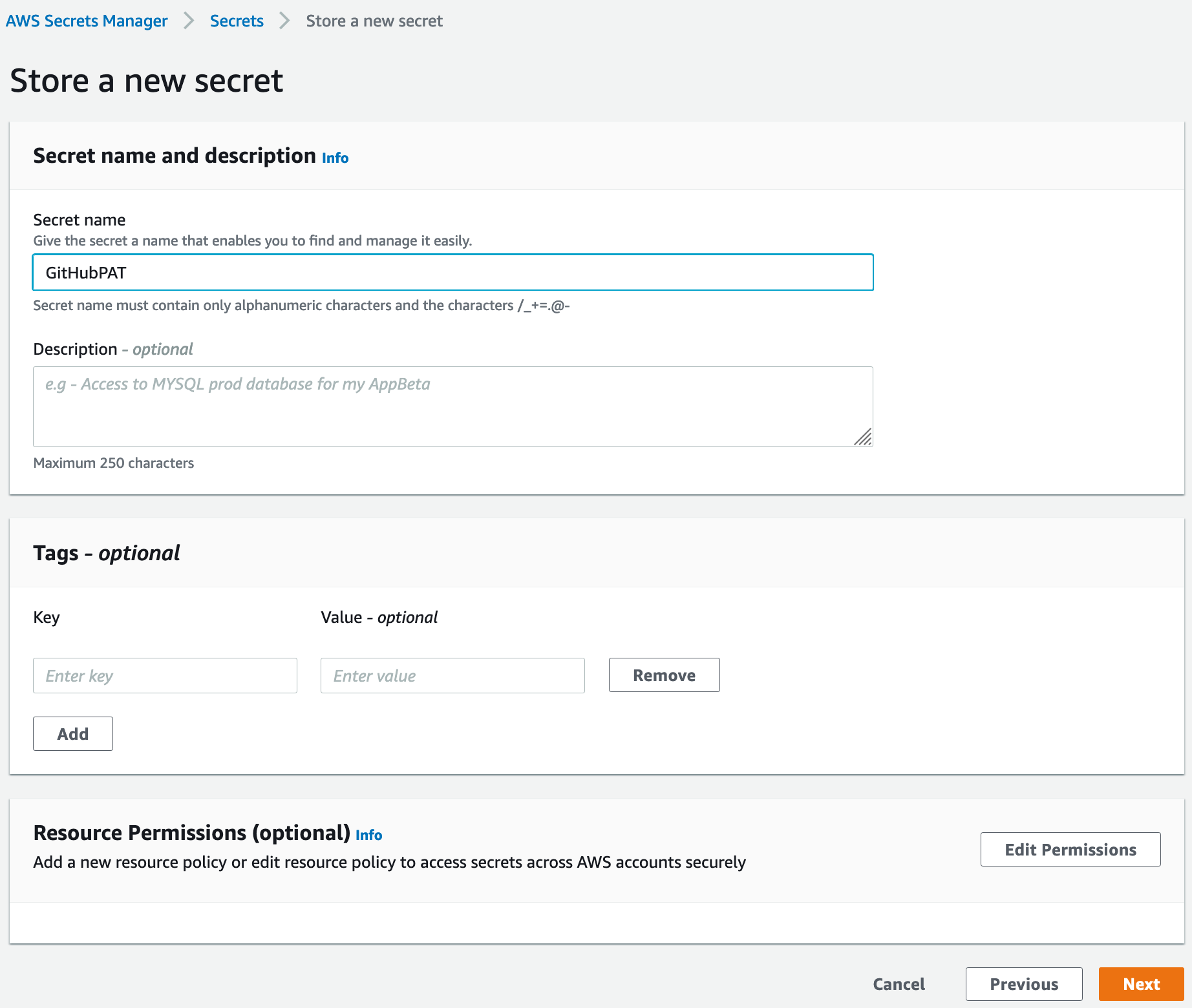
Choose a name for the secret (we’ve chosen GitHubPAT here), then click Next through the remaining screens and save the secret. Once the secret is created, you’ll find it in the list of secrets. If you click on the secret, you’ll see the secret ARN in the fields.
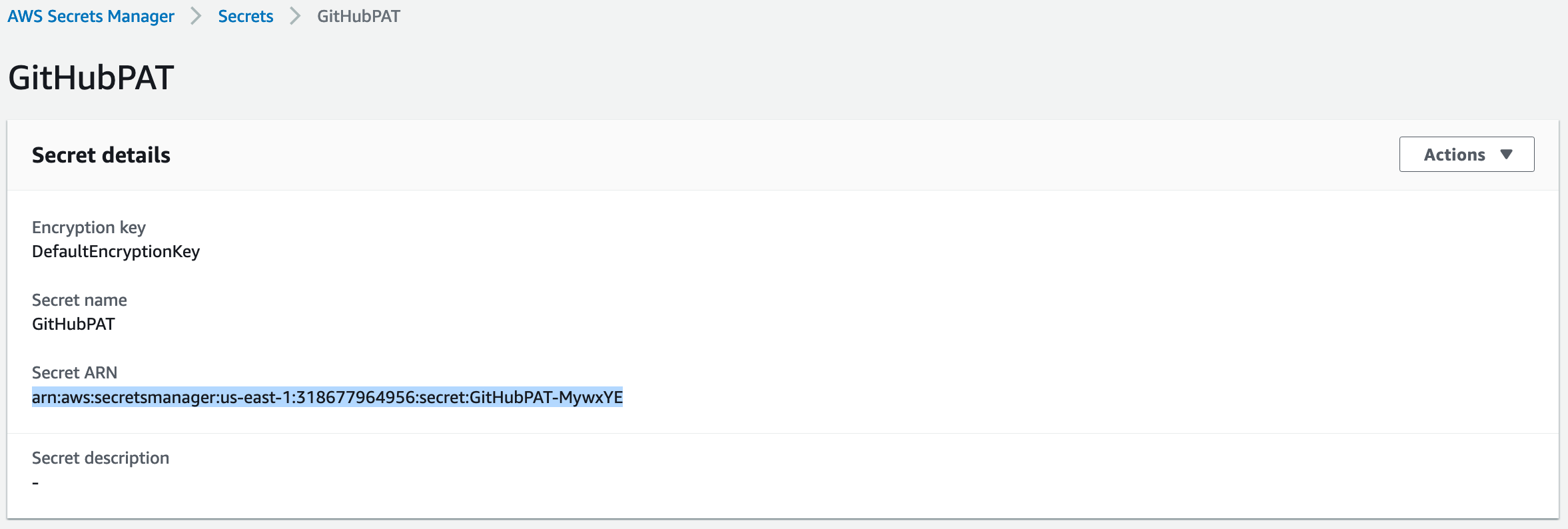
In the ref arch form, VCSPATSecretsManagerARN is where you enter this ARN.